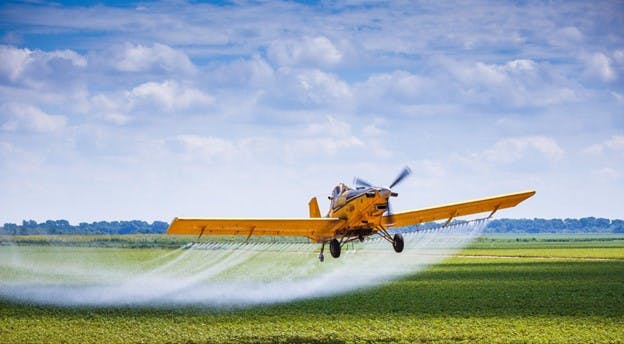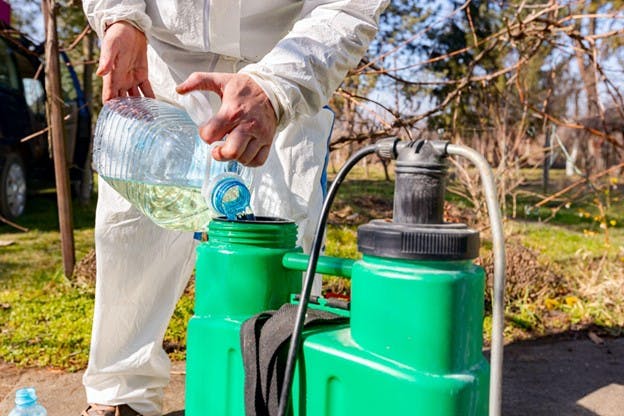October 2023
How to Eliminate Water Pesticides from Your Tap
While the organic food movement has sprung up around the desire to eat fewer pesticides, your municipal water supplier doesn’t offer an organic option. And unfortunately, the water pesticides concern in the United States and Canada is real. All those pesticides we use to grow food and keep pests out of our yards and houses can find their way into our drinking water supply, and to your tap.
But is the concentration of pesticides in your water something you need to protect yourself from? In this article we’ll look at what types of pesticides are in your water, how exactly they get there, and which ones you need to look out for.
What Are Pesticides?
Pesticides are substances or mixtures of substances that kill or repel plant, animal, or microbial pests. Insecticides, rodenticides, fungicides, and herbicides are all types of pesticides that are used in pest management.
There are many formulations, brand names, and delivery systems for pesticides. The delivery method can range from ant traps you may use in your home to industrial weed killers applied by crop dusters to agricultural land.
Each type and delivery method has advantages and disadvantages. Some of them are very good at killing their intended target but are highly toxic and can affect nearby ecosystems in unintended ways. There are adverse effects of pesticides, like damage to nearby wildlife, aquatic life, and even people and their pets.
How Can Pesticides Contaminate Water?
The use of pesticides and fertilizers is common in agricultural areas, parks, and homes. After any sort of pesticide application, there is a chance of water contamination through the soil leaching into groundwater. It can also get into the storm runoff and flow into lakes, rivers, and other surface water systems that feed drinking water supplies.
While water treatment is a priority for municipal water suppliers, removing all the pesticides from contaminated water can be a big challenge. The U.S. Environmental Protection Agency (EPA), who regulates drinking water across the U.S., imposes limits on many commonly used pesticides. However, the EPA has to take into account both health effects and the cost of removal. If it’s too costly to remove all pesticide residues and there is low risk of acute illness, the levels may be allowed even if there is some evidence of health risks over time.
In some cases, pesticides like atrazine that have been made illegal in other countries due to known public health risks, are still in use and found in water supplies in the U.S. and Canada.
What Types of Pesticides Are Found in Water?
Let’s take a look at some of the more common pesticide categories and individual pesticides, what they’re used for, and whether you should be concerned about them.
Organophosphates
This is a category of pesticides used primarily for killing insects but they’re also the basis for nerve gas weapons. They work by disrupting the nervous system of the pest. Due to their toxic nature, they can pose risks to human health and aquatic life.
Acute toxicity symptoms include increased saliva and tear production, diarrhea, nausea, vomiting, small pupils, sweating, muscle tremors, and confusion. While acute toxicity isn’t likely in the amounts found in public water supplies, the less exposure to organophosphates we have, the better.
Chlorpyrifos
A specific type of organophosphate pesticide, chlorpyrifos is used in agriculture to control foliage and soil-borne insects. It's effective, but has been the subject of health concerns, which led the EPA to ban its use on food crops recently. However, it can still find its way into the water supply from use on other crops.
Chlorpyrifos has a low water solubility and binds well to soil. It also presents a high risk to aquatic environments and human health, so it is closely monitored.
Carbamates
Another category of insecticides, carbamates are generally considered less toxic than organophosphates but still warrant attention. Carbamates are used in agriculture and in homes to kill a wide variety of common insects like cockroaches, fleas, ticks, ants, mosquitos, and more. They are also known to contaminate water supplies at sometimes concerning levels.
Exposure can cause nausea, headaches, dizziness, and weakness.
Imidacloprid
This is a neonicotinoid insecticide mimicking nicotine, which is known to be toxic to insects and humans. Imidacloprid is used for a variety of applications including pets, home pest control, and agriculture. While effective against sucking and chewing pests like termites and fleas, it has been linked to declines in pollinator populations.
While not considered dangerous in negligible amounts, a recent federally funded study by the U.S. Geological Survey (USGS) and the University of Iowa are pointing to evidence that imidacloprid and its metabolites might become more dangerous when interacting with tap water.
Metolachlor
An herbicide that controls pre-emergent grasses and weeds, metolachlor is often used on corn, soybean, and sorghum crops. It also has non-crop land uses just about anywhere weeds need to be managed. Metolachlor can seep into freshwater aquifers and other water resources through agricultural runoff.
Probably one of the least toxic pesticides to humans on this list, the U.S. EPA still considers it to possibly be carcinogenic.
Acetochlor
This is another herbicide used for controlling weeds in corn fields. Its use has been restricted because it has been found in watersheds around agricultural lands. Acetochlor is considered toxic to honeybees and fish. The health effects in humans at low exposure levels is currently unknown according to the U.S. CDC. The U.S. EPA thinks that it’s likely to be carcinogenic at higher levels of exposure based on past animal studies.
Atrazine
Atrazine is an herbicide that has been banned in the European Union since 2003 and many other countries since. It’s used on cornfields, sugar cane, sorghum, and residential lawns in the U.S. and Canada. Atrazine has been found in city water supplies and private wells and has been linked to endocrine disruption, reproductive issues, and cancer in humans and animals.
The U.S. EPA is now beginning to impose restrictions on the use of atrazine and warns that any amount over 3 parts per billion in water can cause negative health effects in people.
How Long Do Pesticides Last in Water?
There are many different types of pesticides, and they all break down in their own time. Some, like chlorpyrifos, have very low water solubility and will last a long time. Most seem to stick around for a few weeks to a few months in water and soil.
How Do You Get Rid of Pesticides in Water?
If you have some water pesticides concerns, you’re not alone. While water treatment plants remove some pesticides, the methods most use (chlorine and ozone) only remove 60-70% of pesticide contamination from water samples and this treatment can cause dangerous trihalomethanes (THMs) to form. This can be increased to over 90% by also using a high-quality activated carbon filter. These filters can even remove some of the THMs and chlorine residue left over.
However, if you want the cleanest water possible, a reverse osmosis or a catalytic carbon filtration system will do the best job for you.
Does Boiling Water Remove Water Pesticides?
No, boiling water does not remove pesticides from water. Boiling water is a great way to kill bacteria, viruses, and other waterborne pathogens but it’s not a good way to deal with chemicals, pesticides, metals, or minerals. In fact, it can even concentrate them as the water evaporates out and leaves the chemicals, metals, and minerals in a higher concentration in the pot.
If you want to remove pesticides from your water, the best way is using chlorine treatment and a high-quality water filtration system that uses activated carbon, catalytic carbon, or reverse osmosis. This can remove over 90% of the pesticides found in water.
How Do Pesticides Affect Human Health?
With so many pesticides out there that work in so many ways, it's hard to say how pesticides affect human health. Pesticides' effect on human health has to do with how high the dose is, over what period of time the exposure lasts, and what type of pesticide it is.
Some pesticides are known to cause neurological problems. Others can cause reproductive issues, respiratory problems, dizziness, nausea, headaches, and more. Several pesticides are even thought to be carcinogenic.
What Is the Danger of Having Pesticides in the Water?
The water pesticides concern from health authorities stems from many places. Pesticides are designed to be toxic to some forms of life. When pesticides get into watery environments, they can disrupt entire ecosystems and hurt the vital plant and animal diversity needed to thrive.
Pesticides also affect your drinking water quality as water treatment plants only remove 60-70% of the chemicals that concern health authorities most.
Get High-Quality Drinking Water Without the Pesticides
The use of pesticides has helped people grow more food and limit disease spread by pests but it’s not without a cost. Pesticides have damaged ecosystems and contaminated our drinking water supplies. While we can’t fix the environmental water pesticide concerns, HomeWater can help you get clean water from every tap in your home.
The HomeWater UPSTREAM™ 4-Stage Whole Home Water Filter uses catalytic carbon to remove pesticides, herbicides, THMs, chlorine, chloramines, hydrogen sulfide, volatile organic compounds, PFOS/PFAS, heavy metals, turbidity, sediment, dirt, rust, and microplastics.
You’ll rest easy knowing you have the safest and best-tasting water every time you turn on your tap.


